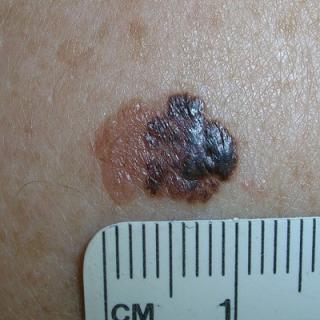If you’re preparing for the United States Medical Licensing Examination® (USMLE®) Step 1 exam, you might want to know which questions are most often missed by test-prep takers. Check out this example from Kaplan Medical, and read an expert explanation of the answer. Also check out all posts in this series.
A 35-year-old woman comes to the physician because of a lesion on her neck. A photograph of the lesion is shown. The lesion has expanded significantly over the last few months. She reports no other symptoms. Her past medical history is unremarkable. Excisional biopsy of the lesion demonstrates locally invasive neoplastic cells with large nuclei, atypical mitoses and abundant lymphocytes. The lesion stains positive for HMB45 and S-100 on immunohistochemistry.
Which of the following factors is most predictive of the patient's long-term survival?
A. Darkness of lesion.
B. Degree of color variation.
C. Depth of lesion.
D. Diameter of lesion.
E. Mitotic rate.
The correct answer is C.
Kaplan Medical explains why
Depth of malignant melanoma is most prognostic. This cancer is derived from melanocytes, which produce melanin. Key features of the primary lesion can be summarized with the mnemonic ABCDE:
- Asymmetry.
- Borders (irregular).
- Color (variegated).
- Diameter (greater than 6 mm).
- Enlarging (implies vertical or horizontal growth).
Melanomas can develop either de novo or in an existing mole. Excess sunlight exposure, fair skin, and a weakened immune system are major risk factors. Pathologic features of the disease include dysplastic melanocytes and immune cell infiltration. Additionally, since melanocytes derive from the neural crest, melanomas stain positive for S-100, as well as HMB45 (melanoma marker), on immunohistochemistry.
Depth is the most important prognostic factor since the lymphatics of the superficial dermis lie about 1 mm under the skin surface. Invasion to this depth is associated with a much higher incidence of metastasis than is seen with a more superficial lesion. Melanomas are notorious for their metastatic potential; they can metastasize anywhere (e.g., brain, bowel) and anytime (decades from excision of primary lesion). Other important prognostic variables include lymph node involvement and presence of distant metastases.
Why the other answers are wrong
The other answer choices are proper tools for diagnosing and characterizing a potential melanoma lesion. However, these measures are not as important in melanoma prognosis as is the depth of the lesion.




